He's in there somewhere
Napoleon Bonaparte was born on the 15th of August 1769 at Ajaccio on Corsica - which had only just been sold to France by the Italian state of Genoa. So by one of those odd quirks of fate, technically he wasn't really French. But by the time he died in 1821 he had become a national icon - despite being twice sent into exile over half a million people lined the route of his Parisian funeral in 1840. The state had to find a fitting resting place for the great man, even if he had 'never fully mastered French and his spelling left a lot to be desired,' according to NapoleonGuide.com.
In the end, the large ex-barracks and military hospital of the Hotel des Invalides was chosen, and his coffin laid in the Eglise du Dome that can be seen from all over central Paris. The large formal barracks building is crowned with a giant spired golden dome that rises brightly amidst all the other notable landmarks nearby. It was re-gilded in 1989 using 12kg of gold, and it certainly stands out. Although the church was begun in 1677, the monument was completed in 1861 when his remains were laid to rest. To visit, you buy a ticket that also allows entry into the Musee de l'Armee, which is currently half-closed for renovation, and walk back out to the front and climb the steps to the main entrance.
What hits you first is the sheer scale of the Mausoleum - the inner cup of the dome soars away above your head, covered in more gold and painted murals of the General's greatest triumphs. Large alcoves stretch away from the centre, each housing the tomb of a notable French military leader. Marechal Foch - the Allied Commander of WWI forces - has the most poignant, a life-sized grey marble statue of six French soldiers carrying his body on a stretcher. However, this pales into insignificance when you reach the centre of the church, and see the huge circular hole housing Napoleon's Tomb. Built into the crypt level is a mammoth red wooden casket made from Finnish Porphyry. Inside are five successive coffins (tin, mahogany, lead, lead again, and ebony), and inside that are the ashes of the man himself.
Egotistic isn't the word. If there was a statue of him and a large coffin, that would be understandable - but this monument is incredible. Walking down a set of stairs behind a gilded and mirrored altar takes you level with the tomb, and a large circular chamber. Here the walls are covered in marble frescoes of Napoleon in God-like poses handing out decrees to subserviant minions. One of the quotes on the wall translates as 'By it's simplicity my code of law has done more good in France than all the laws which have preceeded me'. He wasn't shy about self-promotion, that's for sure.
I wasn't really sure what to make of the tomb. Napoleon was undoubtedly a great figure and a leader - and he's still incredibly popular in France. Walking through the War Museum afterwards I could see how proud they are of their military tradition, and only Charles de Gaulle is comparable to the pint-sized Corsican. Someone of that legend should be given a suitable and fitting resting place. But although I was staggered by the scale of the thing - so the 19th Century designers had succeeded in their aim, it left me uneasy. I don't remember Wellington's grave at St Paul's Cathedral in London being anything like it. What about the 550,000 men of the Grande Armee who died on his madcap campaign into Russia? For me, one of the most telling things about Napoleon is that in the Eglise du Dome you'll find the grave of his son - buried under a statue of himself.
Sunday, February 26, 2006
Napoleon's Grande Tomb
Wednesday, February 22, 2006
Grande Galerie
Extinct Giant Auk, or Penguine Grande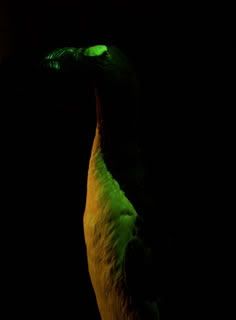
One of Paris's lesser-known indoor attractions is the Grande Galerie de l'Evolution, perfect for a wet and blustery Saturday afternoon. Part of the elegant sprawl of the Museum National d'Histoire Naturelle - Natural History Museum to you and me - to reach it you walk through the Jardin des Plantes, an elegant structured garden to the South of the River Seine. Originally laid out as a medicinal herb garden in 1626, the site has now become a sort of Botanic Gardens, with rows of neat muddy borders awaiting some Spring growth. Two large glasshouses dominate the garden - both of which are currently undergoing renovation and are closed.
The Gallery of Evolution (to give it an English name) is on the South side of the complex, next to an imposing grey museum of Mineralogy. My guidebook described the old-style museum buildings of Paleontology, Anatomy, Mineralogy, Entomology, and Paleobotany as 'musty'. Refusing to accept anything involving insects could be so categorised, we attempted to get into the Entomology Museum but were turned back by a book-reading academic at the desk who informed us it wasn't a museum, but a collection of specimens off-limits to the public. Musty old bugger.
So we piled out of the rain and into the Evolution Gallery - a 19th Century glass-domed building with four floors of stuffed animals and exhibits on the interactions between animals and the environment. It was very interesting, if hard to understand as 95% of the signs were in French - but a stuffed Polar Bear looks the same in any language. The bottom floor had all kinds of wierd aquatic stuff in jars, so that more than made up for our refusal at the Entomology Museum.
As it was, that was kind of fitting, as I discovered later that the frustrated Ecologist Jean-Baptiste Lamarck had been appointed 'Professior of worms and insects' at the Museum National d'Histoire Naturelle after the French Revolution. Perhaps in that very building he started to work on his radical theory about animals adapting to environmental pressures that preceeded Darwin's by many years (sadly he was derided and died blind, and in abject poverty). On the other side of the square was the building where Henri Becquerel discovered radioactivity (1896), and the Curies discovered Radium (1898) - so maybe best avoided, but wherever you go in Paris, you'll find something historic.
Monday, February 20, 2006
Avec les Nuns
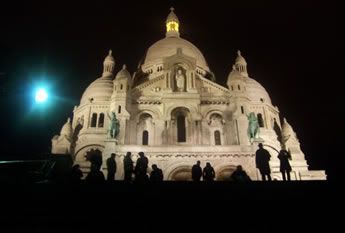
Friday night was the only time where all eight of us would be together in Paris (Tim would be the first to leave, on Saturday night) - so we went for a big night out. First we took the Metro to Chatelet and tried a French-style pizza, or Flam. According to the menu they originate in Western France, and apparently there is something different about the base - it certainly seemed more crepe-like than pizza-like; but it was good stuff. The restaurant was packed, and there was a great atmosphere.
After that we walked down to the Seine just in time to see the Eiffel Tower shimmer, as it does for a minute on the hour. I'd seen it before, but it always impresses me. I can't remember why they started it, but it proved so popular that the authorities decided to keep going. Hundreds of thousands of light bulbs flash on and off, and the entire tower sparkles - it really is something else. Also down by the river we came across a sudden commotion and a rushing group of rollerbladers appeared, followed by blaring police lights and motorbikes.
At first glance it looked like they were being chased, but it was the legal street run that takes place every Friday night - hundreds of skaters whizz through the roads, which are temporarily closed to let them go safely. Originally it was illegal, started by some hardcore types, but eventually the sheer popularity of the event forced the police to legitimise it and offer an escort to cut down on accidents. The route changes every week, and if you've got some skates you can join in, apparently.
A trip on the Metro later and we were in Oberkampf, a suburb in Eastern Paris. Erika had arranged for some of her friends to come out, and we had to meet them at a place called the Nun's Cafe. Not sure what to expect, we turned up and found a small, smokey bar with not a Nun in sight. Nobody seemed to know why it was so called, but nobody seemed to care either. We stayed there until it closed at 2am, driking the local beer out of small glasses and trying to speak French to Erika's friends - who needless to say were all fluent in English. I think my French actually improved the more I drank, which is something I'll have to remember for the future...
Saturday, February 18, 2006
Napoleon's Grande Arc
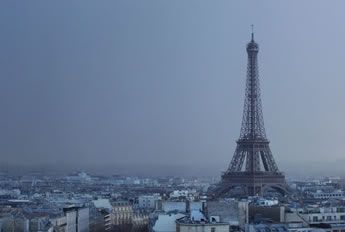
In all my previous visits to Paris, I'd never been to the Arc de Triomphe - so we took care of that today. A quick rattle along le Metro to Charles-de-Gaulle-Etoile and we popped up at the imposing archway, looming over the traffic. Begun by Napoleon in 1806, it wasn't finished until 1836, and stands as a monument to France's armies. The traffic around the base is something to be seen, but thankfully an underpass spirits you to the base of the Arch without the need to risk your life above ground. The underside of the Arc is elegantly carved with the names of 660 Generals and various battles in which they distinguished themselves. Also underneath is an eternal flame to commemorate an unkown soldier from the Great War.
For €8, you can climb almost 300 steps to the top, which has a small museum to Napoleon and the campaigns of his time. Maps and plans of the Battle of Austerlitz line the walls, together with reproductions of the big man's battle tent and living quarters while he was overseeing his armies in action. He didn't half do things in style. A few more steps brings you blinking onto the roof, with stunning views all over Paris. In some respects, it's better than the view from the Eiffel Tower (as you can't see the Tower when you're up it).
Radiating off in all directions are imposingly straight roads, lined with tiny people rushing about, and clogged with cars and buses. In the distance the slight rise of Montmartre is given away by the pinnacle of the Sacre Coeur rising over the buildings. In the other direction are the tower blocks of the business district with the enormous square of la Defense sticking up like the other goal on a giant football pitch. The views are fantastic, especially looking down at the madcap traffic, as vehicles funnel into and out of the Place d'Etoile like blood cells shooting through veins.
We stayed up there for about half an hour, watching a storm cloud run over the East of the city. Eventually the rain reached us and arrived almost horizontally, whipped in by the strong wind. Taking cover behind one of the walls at the top, there was just time for another photo of the Eiffel Tower before we dashed down for the dryness of the interior and the long trek down the steps to ground level.
Friday, February 17, 2006
The most famous...
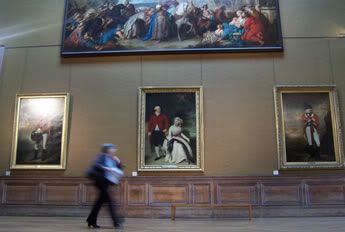
Is there a more famous museum in the world than the Louvre? Not that I know of - and despite this being my fifth trip to Paris, I'd never actually been inside. Today was another dull grey morning, perfect for indoor things, so after a quick Metro trip into the city we found ourselves walking through the blustery Jardin de Tuileries towards the famous glass pyramids. The original Palais de Louvre was constructed in 1190 by Philippe-Auguste as a place to store his weapons, but it wasn't until 1360 that a king (Charles V) decided to live in the Palace. Eventually art was stored there, and it opened as an art gallery in 1793, the same year Louis XVI met his untimely and painful end. It also proved a convenient place for Napoleon to store his massive amounts of war booty, so the collection grew and grew.
Today it houses hundreds of thousands of paintings, sculpture, relics and artefacts from all over the world (which was news to me - I thought it was just paintings). To get in, you join a queue to descend an escalator for a cursory bag check, and then line up to pay your €8.50 - not a bad price when you think about it. The Museum is laid out over three enormous wings - Denon, Richelieu, and Sully. Just standing in the foyer gives you an idea of which is the most popular - Denon - because of one very special painting.
If the Louvre is the most famous museum in the world, then the Mona Lisa is without doubt the most famous painting, and of course the Louvre's star attraction. We were pulled along in the tide of people walking briskly past masterpiece after masterpiece when the corridor opened up and turning to the right, there she was. I had wanted to take a picture of the crowd of gawkers looking at it, but photography was strictly not allowed - ostensibly to avoid harsh flashes damaging the painting (sheltered behind a double layer of darkened bullet-proof glass), but the massed ranks of reproductions in the gift shop must have had something to do with it.
It's a beautiful painting, there's no denying it - but I wasn't blown away by the majesty of la Joconde as some are. Admittedly, I know very little about painting and art, but the other early renaissance pictures there were just as impressive - it's difficult to see just what makes that particular one stand out. Still, it was nice to look at for a while, and I guess that's what paintings are all about.
After the 'large Italian artworks' we wandered through the rest of the Denon wing, and by chance found ourselves in a small gallery of indigenous art from the Pacific region - a relatively new addition to the more traditional arty stuff. They even had an Easter Island stone head. The throng of people had thinned here, but increased dramatically as we wandered along the lower Denon through classical Greek sculptures. After a slight detour through a wonderful section of Roman mosaics, we came on a long pillared corridor with the Venus de Milo at the end. I hadn't known it was in the Louvre, so we had a close look and tried to avoid getting in the way of photograph-takers. It's a stunning statue, although all I could think of was the episode of the Simpsons where Homer goes to the candy fair and ends up stealing the jelly Venus de Milo and having to run for it.
At this point, we'd been in the Louvre for hours - hours of culture and enlightenment - but still hours. Around the Egyptian antiquities section we ran out of steam. When mummies don't get your interest levels up, you know it's time to go. So in the end we'd seen barely half of the Louvre's treasures - but at least we'd knocked off the 'big two' and seen a few more interesting bits and pieces, from Roman daggers to genuine Totem poles. And here's me thinking it was just paintings...
Thursday, February 16, 2006
La Cité
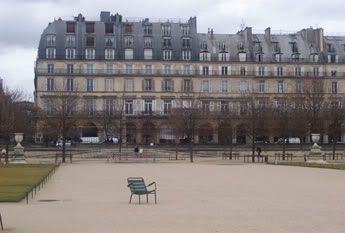
So, I'm back on the road - in Paris. I started off yesterday arriving on a tiny plane from Edinburgh (only about 20 people on board). The massive grey Charles de Gaulle airport was deathly silent, and I managed to get to the gare and find a train for the centre of Paris. I was due to meet my friend Erika at the Gare du Nord, but she was having her hair done and I had to wait around for a while at the station.
She soon arrived though, and we walked to her studio flat (a French euphamism for tiny flat) and dumped my stuff. We had picked up some cakes on the way, so before I'd even taken my shoes off I was tucking into the good stuff. We had to scoot over to Porte Maillot to meet another friend who was arriving from Beauvais airport, then went out for dinner. Erika was getting a few admiring French glances for dining out with two men on Valentine's Day - this is Paris after all.
The next morning, Tim and I set off to wander around in the light drizzle, and covered a fair proportion of the touristy stuff (it was his first time in Paris). The top of the Eiffel Tower was closed because of the strong winds, so we continued our ramblings, stopping off for a few cakes - it's got to be done. By 4pm we'd walked so far it was all we could do to stumble onto the Metro back to Chez Erika and flop on the sofa. Fortunately, a Japanese dinner revived us, and we went to a tiny bar near the Sorbonne, full of glamorously smoking students watching the rain drip through a crack in the ceiling...
Saturday, February 11, 2006
Every man's worst nightmare

No, not a giant jellyfish (more of that later) - but a disrupted Saturday routine. The traditional Saturday afternoon of sport on the telly, that great British tradition, ruined by the very worst...a broken television. The coupons had been placed, the tea freshly brewed, the papers on the table. It was all going so well. For the past few weeks the TV has been making odd squeaking noises, and suddenly turning itself off without warning. We thought this was just a defence mechanism whenever Celebrity Big Brother came on, but recently it's been getting far worse. Yesterday I spent the last of my pools winnings on a new Xbox game, only to be stymied by the TV turning itself off nine times in twenty minutes.
This afternoon the telly finally gave up the ghost, turning off seconds after it was turned on. Every time we pushed the button it would instantly shut down like a tetchy child not wanting to play. And all this was just as Sky Soccer Saturday was coming on - you can't get worse timing. The programme where a panel of football experts watch the live games and describe what's happening (to get round the rules preventing showing of live games at 3pm on a Saturday). As my Mum describes it - "Men watching men watching football". The wrecked television prompted us to sink to increased levels of bizarre desperation - as we plugged the digital receiver into the hi-fi, and became 'Men listening to men watching football'.
What with Match of the Day on later, not to mention the Winter Olympics (or the Olympic Winter Games as they seem to have re-branded it) - desperate measures were called for. When you stand a chance of missing the biathlon, I think you'll agree you've got no choice. So we went into the city to buy a telly. Sadly, the major retailers don't stock TV's anymore - they have display models. You choose the one you want, and it gets delivered within 28 days. "28 days?", I squawked at the bloke in Dixons. "But it's the women's moguls on in an hour!!". He looked at me like he didn't care whether I lived or died, and informed me that their warehouse is expecting a delivery in two weeks.
So we trudged home in what had become pouring rain, and took the TV apart to fiddle with the dusty wiring. After putting it back together, nothing was happening, and I was just about to reach for a book and read (on a weekend!!) when astonishingly the telly spluttered into life and stayed on for more than thirty seconds. That was four hours ago, and we're too scared to turn it off. We even managed to watch the women's moguls (what does that do to the knees?) - so crisis averted. I put down the hammer, and the book stayed in the glass case.
So next week I'm off travelling again. Yes, this erstwhile travel blog will move away from talk of trainers and flags and get back to why it was started. Although if I eat any good pies, you'll be the first to know Michele. I'm going to Paris for a week to catch up with my old friend Erika - I've not been there for a couple of years, so am really looking forward to getting back. In total, 7 of us are going over, so it should be a great week. Until then - au revoir, and salut maintenant...
Oh, the jellyfish. I just liked the picture. Giant Jellyfish invade Japan
Wednesday, February 08, 2006
Vexillology

The study of flags.
When I was younger, I was a committed vexillophile. Before the News of the World send a hit-squad round to get me, I should say that it means 'someone who loves flags'. Why did I? I can't really remember - probably the mixture of exotic-sounding foreign names, far-away places and bright colours. I remember a 'Flags of the World' poster I had, which I knew so well I can still describe almost any flag at random. Of course, this is utterly un-useful - apart from during an old episode of The Amazing Race on the TV where the contestants were in the Philippines and had to land their small boat on whichever island had the national flag on it. Before we'd seen any of the options, I turned to my flatmate and said 'White triangle with star, upper blue band, lower red band', causing him to inch his chair away from me slightly.
If you like colourful rectangles, you should pay a visit to Nationmaster.com, which has over 49,000 flags, of every country in the world and then some. From the Cypriot Police Force to the Scout Association of Kazakhstan, if it has a flag, you'll find a picture of it there. Want to know the flag of the Bulgarian Ministry of the Interior in 1955? No, thought not. Still, if you did, it's on Nationmaster. Here are some of my favourites...

Qasigiannguit, Greenland.
Not enough global flags feature prawns, in my opinion. Here is the website of Qasigiannguit, which is written in the local language that has some of the longest words I've ever seen. Want to have a stab at pronouncing oqaluttuarisaaneranut? The flag represents the prawns that are the life-blood of the town, in their cooked and raw state. The 'friendly' town is situated in the improbably-named Disco Bay.
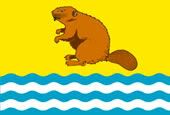
Municipality of Bievre, Namur, Belgium.
Bievre...Beaver. I get it. Not sure why it's by the seaside - but it looks mightily annoyed. Must have lost his frisbee, or something. Bievre is twinned with Desborough, Northamptonshire.
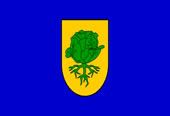
Vidovec, Varazdin, Croatia.
I don't know what Vidovec means, but it probably doesn't smell that nice there.

Municipality of Ciney, Namur, Belgium.
I presume this design is an old heraldic motif of squires or pages or something, but it just reminds me of a prog-rock video.

Aklavik, NW Territories, Canada.
This one's tremendous - it features a book, a rat, and the motto 'Never Say Die'. After a bit of crafty Googling, I learned all about the 'Mad Trapper of Rat River' - presumably he of the 'Never Say Die' attitude, as it took seventeen men and a strafing from a fighter plane to bring him down. They obviously breed them tough up in Aklavik.
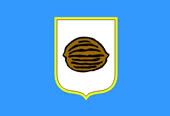
Orehovica, Medjimurje, Croatia.
I wonder if the walnut-people of Orehovica live near the Cabbages of Vidovec?
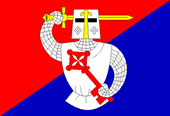
Nezdenice, Czech Republic.
Many European flags have heraldic backgrounds. This one is by far the best. It seems to be based on the limbless Black Knight from Monty Python, stabbing himself through the head with his sword. Watch out for that menacing-looking giant key though.

Rakuvka, Czech Republic.
A lobster juggling mushrooms - something you don't see every day...
<
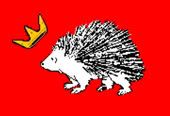
Coudekerque-Branche Municipality, France.
I know the French like to play boules (or they do on TV programmes I've seen), so this 'throw the crown on the hedgehog' could be a local variation. Maybe you win a goldfish if you manage it.
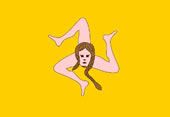
Sicily, Italy.
'When Yoga goes bad'

Lofa County, Liberia.
Absolutely no idea - it seems to be an arm planting a sausage aross a river. Symbolic?
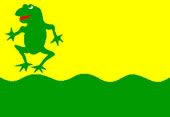
Hijum, Netherlands.
'So what shall we put on the flag guys?'
'How about a dancing frog?'
'Why not?'
Thanks to Flags of the World for descriptions and pictures.
Monday, February 06, 2006
Super Sunday

Yesterday was 'Super Sunday' - the annual orgy of consumerism that surrounds the final game of the American Football season. As usual, I stayed up to watch it - although last year in Australia it was on at breakfast time, which was odd (beer and cornflakes don't really go together). The game this year pitted the Seattle Seahawks against the Pittsburgh Steelers, and after a slow first half the Steelers wound out winners by 11 points. After Janet Jackson's 'wardrobe malfunction' of two years ago, this year's halftime show (the lengthily-named 'Super Bowl XL Sprint Half-time show featuring the Rolling Stones') was supposed to be family-friendly. I was delighted to learn that two of out their three songs were censored by panicky TV executives. The five-second delay obviously paid off as they saved the global public from hearing Mick Jagger complete the fantastic couplet:-
One time you were my baby chicken
Now you've grown into a fox
And once upon a time I was your little rooster
Am I just one of your c****?
Answers on a postcard...
Apart from archaic censorship, American sports are dominated by statistics and numbers. As an enthusiast of stats and facts, I collected a few Super Bowl facts. Enjoy!
- Fans at the game ate 5,000lb of hotdogs, which stretched end to end would reach 5 miles
- 24,000 cans of soda were sold at the Superbowl - more than 85 elephants drink in a day
- Super Bowl XXXIV (2000) ads cost an average of $73,333 per second
- Eight percent of those watching will be tuning in just to see the ads.
- In 1999, ABC made dot-com advertisers pay in advance for time in the advertising showcase
- Super Bowl ticket prices over the years: Super Bowl I (1967) $6-$12; Super Bowl XV (1981) $40; Super Bowl XXII (1988) $100; Super Bowl XXX (1996) $200-$350; Super Bowl XXXIII (1999) $325; Super Bowl XL (2006) $620 (£350)
- A commercial in the Super Bowl will reach 40% of all U.S. households (40 million out of 100 million or approximately 90 million people in the U.S. alone)
- Superbowl weekend will have fewer weddings than any other weekend in the year
- 6% of the American workforce will call in sick on Monday
- 20% of Super Bowl viewers stated they liked the TV ads more than the game
- 38% of people made some type of wager on the Super Bowl
- More Americans watched the 2004 Super Bowl than voted in the 2004 presidential election.
- Half of all Americans would rather go to a Super Bowl party than a New Year's Eve party.
- Two out of five Super Bowl watchers are not even football fans.
- 13% of Americans order takeout/delivery food from a restaurant for a Super Bowl gathering. 58% of them will choose pizza.
- On Super Bowl Sunday, Americans will eat an estimated 20 million pounds of potato and tortilla chips and eight million pounds of avocados.
- Sales of antacid increase by 20% on Super Bowl weekend.
- 35% of those who attend the Super Bowl write it off as a corporate expense.
- 58% of people would rather take their bathroom breaks during the game than miss the commercials.
sources
SuperBowl Monday
Official Super Bowl XL website
The Center for Research on the Effects of Television, Cornell University
Wednesday, February 01, 2006
Academics Anonymous
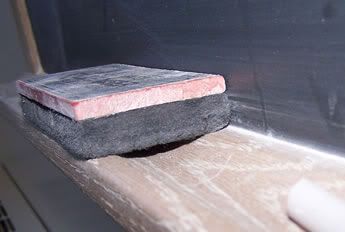
According to a recent survey carried out by a market research company, University students think their lecturers are 'stuck-up, disorganised, unpunctual, unfunny, badly dressed and too desperate to be "hip"'. As reported in the Times and by the BBC, the responses from 648 students found many thought academics were "snooty" and had "objectionable facial hair". I found that amusing, as I remember most of my lecturers would fit the bill exactly - in fact, I wondered why the press seemed to find it so surprising. Mind you, I did study science - a discipline where wild facial hair and crazed expressions seem to be a pre-requisite.
I studied at two Universities, and always marvelled at the mannerisms of some of my lecturers compared to those from other departments. There's something about the Biological Sciences that encourages oddball behaviour, and the longer you spend in that environment, the more infected you become. My supervisor at my first University was a cycling obsessive - so much so that he used to spend all day in his lycra biking outfit, lectures and all. He was a great bloke, if amazingly scatterbrained, and looked exactly like Richard O'Brien from the Crystal Maze. That photo's uncanny, actually. I once left him a vital form to sign, and when I went back a few days later he spent 20mins looking for it. Eventually he found it in the bin, uncrinkled it, signed it with a flourish, and handed it over. I've just checked the staff website, and was pleased to see he's still there.
Another character was a silver-haired biology lecturer who was once described to me as a 'bit of a ladies man' by another member of staff (I have no idea why he told me). He did actually have an affair with a student, but I can't remember if he had to leave because of it - he's not there anymore. His trademark was a large silver belt-buckle of his initials - which mirrors one of the main findings of the poll - "The poll suggests that many students find their lecturers' attempts at being trendy insufferable". I once went to see him to discuss an essay I was writing about deep-sea fish, and he raised a finger with a sudden cry of 'Ah-hah!', and rooted around in a cluttered cupboard before bringing out a blueish deep-sea fish in a test tube. I can only guess as to how long it had been there - or what else was in the cupboard. I once found a dried seahorse on the dashboard of the department minibus.
Academics also have a bizarre sense of humour - I once noted in an ecology paper I wrote about the problems of accurately measuring saplings with a tape measure (because I couldn't reach the tops), only to find the lecturer had written 'SHORTARSE!!' in the margin in red pen. Another left a binliner of fish for us to study in an unplugged lab fridge over the weekend (on purpose I always thought), so when we turned up on Monday morning to sort through them the smell was so awful it almost made the entire class ill. Ahh...happy days...